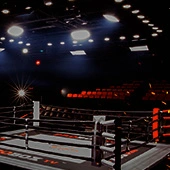by David P. Greisman
While this year’s Olympic boxing isn’t without scoring controversies — just like past competitions both with and without computerized scoring — this year’s games have a different scoring system than in previous tournaments.
Gone is the scoring system in which a boxer would only be awarded a point if a majority of judges hit a button to register a blow within 1 second of each other. Instead, each judge has his or her own individual score — which is why there is no running total on-screen during the course of the round.
Instead, the five judges compile their own scores for each boxer, and at the end of the round, the scoring system selects the three scores for each boxer that are most similar, or closest, to each other, according to an explainer produced by USA Boxing (the source for the information to follow). The average of those three scores then becomes the boxer’s points total for that round, which is why scores are now only announced at the end of each round.
That means that a boxer who judges awarded 4, 5, 7, 7 and 8 points to would have the score averaged out from 7, 7 and 8 — an average of 7.33, which is rounded down to 7 points for a round for that boxer. However, if there’s more than one similar score — say, if the judges awarded 2, 2, 4, 6 and 6 points — then the top and bottom numbers are dropped, and the remaining three numbers are averaged out to leave a score of 4 points for that boxer.
If one boxer receives a warning, his opponent has two points added to his score.
Ties, meanwhile, lead to the “raw individual scores” of three judges being added up for each boxer. If there’s still a tie score after that is done, then the judges vote on whom they think won the fight.
BoxingScene.com spoke via email with John Santore, who worked as the technical lead with the electronic scoring system as a volunteer for USA Boxing. Santore was speaking to BoxingScene.com to help explain the system, though he emphasized that he was not speaking on behalf of USA Boxing.
BoxingScene.com: Why was that change made from the amateur scoring system was we previously knew it to what we see in these Olympics?
Santore: “Not having been privy to the actual decision process of AIBA, I can only speculate. I believe there were three problem areas identified with the old system:
“One, while the one-second window is obviously designed to only record ‘definitive’ blows that three or more judges see, in practice it wound up effectively preventing body blows from counting. While technically a body blow always was a legal scoring blow, given that body blows are usually part of inside fighting, you'd have a situation where not all judges likely had a good angle to witness the blow. Therefore, without three judges scoring it within the one-second window, those blows often weren't counted
“Two, the scoring system had an algorithm built in to evaluate the judging. Specifically, if a particular judge had scores that were either too high, or too low in comparison to the other judges, they wouldn't receive a good evaluation. At international competitions, if you got a bad evaluation, you were removed from the officiating rotation.
“What this did was change the behavior of judges. So if a judge legitimately saw a blow, but they didn't think the other judges would be able to see it, there was a disincentive to score the blow themselves because it would cause their numbers to be out of line with the other judges. Also, the math behind those evaluations tended to favor lower scores, as the lower the scores, the less deviation among the judges, and the less likely for the judge evaluation to flag your scores.
“Three, the old system had live open scoring, which created the whole situation with boxers getting a lead, and then trying to avoid engaging in order to protect their lead.
“Also, in my opinion, it's harder to game this new system. As a hypothetical exercise, I tried considering a case with a deliberately biased judge. The nature of the math of the new system is that anything drastically out of line with other judges gets automatically corrected. Not that it's not possible, but I couldn't come up with a way to deliberately affect the outcome of the bout other than adding a single point (or omitting one) here or there. That's because it needs to be similar to the other judges, so even if you try doing that, you still have a score that's mostly in line with the impartial judges.
“The way that it works is because it’s a round-by-round instead of a second-by-second, if you try to favor one boxer over the other too drastically, you basically mathematically eliminate yourself. Maybe if you have three people who are all biased, you can probably do what you want [to game the system]. You might be able to put a subtle point here and there, but you’re going to be in line with everyone else, and you’re not going to be unreasonable anyway. It’s not an easy thing to do [to game the system], if it can even be done.”
BoxingScene.com: Is it correct that this is also the last Olympics that the scoring system we're seeing now will be used? If so, what's to come, and when? Also, why will the scoring system be changed again?
Santore: “I believe AIBA is reevaluating the scoring system for future Olympics. I have gotten no official word about anything. Everyone is speculating we’re moving to the 10-point must system because the World Series of Boxing was dipping its toe into the pro-style with the 10-point must. Everyone assumes we’re going to the 10-point must. I assume we’re going to the 10-point must. But it’s never been officially confirmed.
“I don't believe anything definitive has been decided at this point, although I do know there were discussions to go to a 10-point must system similar to the World Series of Boxing. I also believe that AIBA is considering doing away with headgear, at least at the top-level international tournaments.
“USA Boxing is in the process of bringing on more computer scoring techs, but we can't finalize details until we know what AIBA is going to do. Right now, that's in limbo until we know more. As for why they are looking to change this, I can only guess. With AIBA's semi-pro World Series of Boxing, they've shown an interest in moving more towards the professional boxing style, and I think the 10-point must and removing headgear are further in line with that strategy.”
BoxingScene.com: What has been your take on the scoring in this year's Olympics so far? How does it compare to the scoring in previous Olympic competitions?
Santore: “I definitely think the current system is a vast improvement on the one-second window system from the 2008 Olympics, and here's why:
“One, right off the bat, we no longer have open scoring. This alleviates the problem where viewers would see a clean blow and then wonder why it 'didn't count,' but also puts a stop to boxers trying to protect a lead by running.
“Two, I think once a viewer gets acclimated to the amateur scoring style, they are seeing scoring numbers more in line with what they actually observe. This is because the new system normalizes scores among the judges on a round-by-round basis, rather than a second-by-second basis. Basically, the numbers are more in line with what a person watching and scoring at home would see.
“Three, while there are always decisions that people aren't going to agree with, it seems like the vast majority of the time, 'the right boxer won' as far as fan perception. And those where they didn't were at least legitimately close. This, I think, is the most important.
“What I'm seeing from reading various comments around the Internet appears to be far less complaints over all. While I'm not sure that any fan of the professional game is ever going to be comfortable with a computerized scoring system, in general, I think there appears to be far less dissatisfaction with the results than in the last Olympics.
“The big controversial bout, which was the Azerbaijani fighter versus the Japanese fighter, was primarily the failure of the referee, not necessarily the scoring system.”
BoxingScene.com: How will the coming change in Olympic scoring (which if I understand correctly will bring us back closer to how things once were in the 1980s and before) work to the benefit, or perhaps to the detriment, of the American boxing program?
Santore: “If, and this is still not decided definitively based on the latest information I've heard, amateur boxing goes to a 10-point must system, I think you have a double-edged sword.
“On the one hand, I think it benefits boxers with a more 'pro style' (effective aggression versus the number of scored punches), which I think would actually benefit Team USA. On the other hand, and we've seen this recently in the pro game with so many controversial decisions, you definitely move towards a more subjective system and the obvious potential abuses for that.”
David P. Greisman is a member of the Boxing Writers Association of America. Follow David on Twitter @fightingwords2 or send questions/comments via email at fightingwords1@gmail.com

